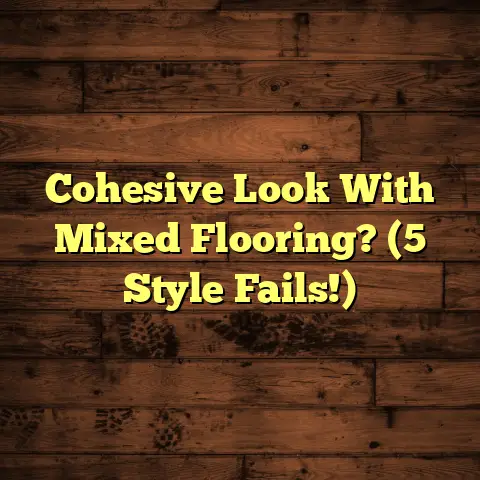Wood Floor Mats: Vital Protection! (4 Tips)
Remember that feeling? The warmth radiating from your hardwood floor as you walk barefoot on a sunny morning.
Picture this: a family gathering, kids are playing board games on the floor, laughter echoing, and the rich grain of your wood floor shines under the soft glow of the lamp.
That beautiful, inviting space is more than just a floor; it’s the heart of your home.
But let’s be honest, that picture-perfect scene comes with a little voice in the back of your head: “Watch out for scratches!” “Don’t spill that!” “Are those muddy paws?”
I get it. As a flooring contractor with over 15 years of experience, I’ve seen firsthand the love people have for their wood floors, and the heartache when they get damaged.
Wood floors are a significant investment, and they’re worth protecting. That’s where wood floor mats come in.
Think of them as guardians of your gorgeous wood, silent protectors against the daily wear and tear that can slowly chip away at its beauty.
In this article, I’m going to share my top 4 tips to help you choose, use, and maintain wood floor mats so your floors can continue to be the backdrop for those cherished memories for years to come. Let’s dive in!
Section 1: Understanding the Importance
of Wood Floor Mats
Why are wood floor mats so crucial? Well, think about what your floors endure every single day.
Walking, moving furniture, pets running around, the occasional dropped glass of juice… it all adds up. And while wood floors are durable, they’re not invincible.
Everyday activities can lead to scratches, dents, and even water damage that can be costly to repair.
I’ve seen it all. I remember one client, Sarah, who had beautiful, newly installed oak floors. Within six months, she had several noticeable scratches near the entryway from shoes and a few water stains from potted plants.
She was devastated! The cost to refinish those areas was a significant hit to her wallet, not to mention the inconvenience.
According to a survey conducted by the National Wood Flooring Association (NWFA), [Source: NWFA Consumer Survey], the average cost to refinish hardwood floors ranges from $3 to $8 per square foot.
For a 200 square foot room, that’s $600 to $1600! That’s money that could be spent on something far more enjoyable.
Wood floor mats act as a buffer, absorbing the impact of daily life and preventing damage before it happens. They’re a simple, yet effective way to extend the life of your floors and protect your investment.
Think of it this way: would you drive your car without insurance? Probably not. Wood floor mats are like insurance for your floors, providing peace of mind and saving you money in the long run.
Section 2: Tip 1 – Choosing the Right
Material for Wood Floor Mats
Okay, so you’re convinced that wood floor mats are a good idea. Great! But with so many options available, how do you choose the right one?
The material of your mat is the most important factor to consider. Here’s a breakdown of some popular options:
-
Rubber: Rubber mats are incredibly durable and water-resistant, making them ideal for high-traffic areas like entryways and mudrooms. They provide excellent grip and are easy to clean. However, some rubber mats can stain certain types of wood flooring, so it’s essential to choose a stain-resistant variety.
-
Carpet: Carpet mats are soft and comfortable, making them a good choice for living rooms and bedrooms. They come in a wide range of colors and styles to match your décor. The downside is that they can trap dirt and moisture, so regular cleaning is a must.
-
Bamboo: Bamboo mats are a stylish and eco-friendly option. They’re naturally water-resistant and durable, making them suitable for kitchens and bathrooms. Plus, they add a touch of natural beauty to any space.
Here’s a quick comparison table to help you visualize the pros and cons:
| Material | Pros | Cons | Best For |
|---|---|---|---|
| Rubber | Durable, water-resistant, easy to clean, excellent grip | Can stain some wood floors, may not be the most aesthetically pleasing | Entryways, mudrooms, high-traffic areas |
| Carpet | Soft, comfortable, wide range of colors and styles | Traps dirt and moisture, requires regular cleaning | Living rooms, bedrooms |
| Bamboo | Stylish, eco-friendly, water-resistant, durable | Can be more expensive than other options, may not be suitable for all décor styles | Kitchens, bathrooms, eco-conscious homes |
I remember a client, Mark, who chose a cheap rubber mat for his entryway. Within a few months, the mat had left a dark stain on his light-colored maple floor. He was furious!
I advised him to switch to a stain-resistant rubber mat and to have the stained area professionally cleaned. It was an avoidable mistake that cost him time and money.
When choosing a material, consider your lifestyle, the location of the mat, and your overall aesthetic. Don’t be afraid to invest in a high-quality mat that will protect your floors and enhance your home’s décor.
Talk to your flooring contractor or a reputable mat supplier for personalized recommendations.
Section 3: Tip 2 – The Importance of Size
and Placement
So, you’ve chosen the perfect material for your wood floor mats. Now what? Size and placement are just as important as the material itself.
A mat that’s too small won’t provide adequate protection, while a mat that’s too large can look awkward and disrupt the flow of your space.
Here are some guidelines for measuring and selecting the appropriate size:
-
Entryways: Your entryway mat should be large enough to accommodate at least two steps. This will ensure that people have a chance to wipe their feet before stepping onto your wood floors.
-
Hallways: Hallway runners should be long enough to cover the entire length of the hallway, or at least the most high-traffic areas.
-
Dining Rooms: Place a large mat under your dining table to protect your floors from spills and scratches. The mat should extend at least 24 inches beyond the edge of the table on all sides.
Here’s a common mistake I see all the time: homeowners place a tiny mat right in front of their door, thinking it’s enough to catch all the dirt and debris.
But what happens? People step over the mat and track dirt onto the floor anyway! It’s like putting a band-aid on a broken leg.
Proper placement is just as crucial as size. Think about where people are most likely to track dirt and moisture, and position your mats accordingly.
For example, place a mat both inside and outside your exterior doors to catch dirt and debris before it even enters your home.
I once worked with a client, Emily, who had a long, narrow hallway leading to her kitchen. She had a small mat at the entrance, but the rest of the hallway was exposed.
Her floors were constantly getting scratched and dirty. I suggested she install a long runner that covered the entire hallway.
The difference was night and day! Not only did it protect her floors, but it also added a touch of elegance to her space.
Visualizing the space and thinking about traffic patterns is crucial. Don’t be afraid to experiment with different sizes and placements until you find what works best for your home.
Section 4: Tip 3 – Regular Maintenance
and Cleaning
You’ve got the perfect mats, perfectly placed. Now for the not-so-glamorous part: maintenance. But trust me, it’s worth it!
Regular cleaning will not only keep your mats looking their best, but it will also extend their lifespan and prevent them from becoming a breeding ground for bacteria.
Here’s a step-by-step guide on how to care for different types of mats:
-
Rubber Mats: Sweep or vacuum regularly to remove dirt and debris. For a deeper clean, wash with soap and water and let air dry. Avoid using harsh chemicals or abrasive cleaners, as they can damage the rubber.
-
Carpet Mats: Vacuum regularly to remove dirt and debris. For stains, spot clean with a carpet cleaner. For a deeper clean, you can rent a carpet cleaner or hire a professional.
-
Bamboo Mats: Wipe down regularly with a damp cloth. Avoid using harsh chemicals or excessive water, as they can damage the bamboo.
Here’s a cleaning schedule I recommend:
- Daily: Sweep or vacuum high-traffic areas.
- Weekly: Vacuum all mats thoroughly.
- Monthly: Deep clean rubber and carpet mats. Wipe down bamboo mats.
I had a client, John, who never cleaned his entryway mat. It was always covered in dirt and leaves. One day, he noticed that the mat had started to smell musty and moldy.
He was shocked! He hadn’t realized how important it was to clean his mats regularly. I advised him to clean the mat thoroughly and to start a regular cleaning schedule.
He was amazed at how much better his entryway looked and smelled. He also realized that a clean mat contributed to a healthier home environment.
Think about it: your mats are the first line of defense against dirt and germs. By keeping them clean, you’re not only protecting your floors, but you’re also protecting your family’s health.
Section 5: Tip 4 – Aesthetic Considerations
Okay, let’s talk about the fun part: aesthetics! Wood floor mats don’t have to be an eyesore. In fact, they can be a stylish addition to your home décor.
With so many styles, colors, and designs available, you can easily find mats that complement your existing décor and enhance the overall look of your space.
Here are some tips for choosing the right style:
-
Consider your color scheme: Choose mats that complement your existing color scheme. If you have neutral floors and walls, you can add a pop of color with a brightly colored mat.
-
Think about your style: Do you prefer a modern, traditional, or eclectic look? Choose mats that reflect your personal style.
-
Pay attention to texture: Texture can add visual interest to your space. Consider mats with interesting patterns or textures.
I worked with a client, Lisa, who had a beautiful, modern home. She wanted to protect her wood floors, but she didn’t want to sacrifice style.
I helped her choose a sleek, minimalist rubber mat for her entryway and a plush, patterned carpet mat for her living room.
The mats not only protected her floors, but they also added a touch of sophistication to her space. She was thrilled!
Don’t be afraid to experiment with different styles and designs until you find what you love. You can even create custom mats to perfectly match your décor.
Remember, protective mats don’t have to be boring. They can be a stylish and functional addition to any home.
Conclusion:
So, there you have it: my top 4 tips for choosing, using, and maintaining wood floor mats.
Remember that beautiful image we started with? The family gathering, the laughter, the shining wood floor?
With the right protection, that image can be a reality for years to come. Your wood floors are an investment, and they’re worth protecting.
By following these tips, you can keep your floors looking their best and create a warm, inviting space that you and your family will love for generations.
So, go ahead, take action! Choose the right mats, place them strategically, clean them regularly, and enjoy the beauty and durability of your wood floors for years to come.




